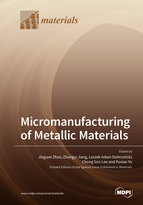Micromanufacturing of Metallic Materials
A special issue of Materials (ISSN 1996-1944). This special issue belongs to the section "Manufacturing Processes and Systems".
Deadline for manuscript submissions: closed (31 March 2020) | Viewed by 49806
Special Issue Editors
Interests: tribology in materials processing; friction and wear; lubrication technology; microforming; advanced rolling; materials processing
Special Issues, Collections and Topics in MDPI journals
Interests: numerical simulation of metal forming; tribology in metal forming; multi-scale materials processing; advanced rolling technology; microforming; manufacturing of composites; contact mechanics; friction and wear in manufacturing; lubrication technology; development of novel lubricants
Special Issues, Collections and Topics in MDPI journals
Interests: materials engineering; nanotechnology; biomaterials; medical; dental; manufacturing and surface engineering; machine building and automation; management and organization
Special Issues, Collections and Topics in MDPI journals
Interests: fatigue behavior of steels, Ti and Mg alloys; formability of structural materials; hydrogen embrittlement of high strength steels
Special Issues, Collections and Topics in MDPI journals
Special Issue Information
Dear Colleagues,
Product miniaturization is a trend for facilitating product usage, enabling product functions to be implemented in microscale geometries, and aimed at reducing product weight, volume, cost and pollution. Driven by ongoing miniaturization in diverse areas including medical devices, precision equipment, communication devices, micro-electromechanical systems (MEMS) and micro fluidics systems (MFS), the demands for micro products have been tremendously increased. Such a trend requires development of advanced micromanufacturing technology for producing high-quality micro products with excellent dimensional tolerances, required mechanical properties and improved surface quality. With the increasing demand for miniaturized products and rapid development of science and technology, a lot of new micromanufacturing technologies have been successfully developed in recent years.
This Special Issue provides an excellent opportunity for those who are studying and working with metallic micro products and their micromanufacturing technologies. Research articles, review articles and communications relating to theory, simulation, processes, properties and applications of micromanufacturing of metallic materials are all invited for this Special Issue.
Dr. Jingwei Zhao
Prof. Dr. Zhengyi Jiang
Prof. Dr. Leszek A. Dobrzański
Prof. Dr. Chong Soo Lee
Prof. Dr. Fuxiao Yu
Guest Editors
Manuscript Submission Information
Manuscripts should be submitted online at www.mdpi.com by registering and logging in to this website. Once you are registered, click here to go to the submission form. Manuscripts can be submitted until the deadline. All submissions that pass pre-check are peer-reviewed. Accepted papers will be published continuously in the journal (as soon as accepted) and will be listed together on the special issue website. Research articles, review articles as well as short communications are invited. For planned papers, a title and short abstract (about 100 words) can be sent to the Editorial Office for announcement on this website.
Submitted manuscripts should not have been published previously, nor be under consideration for publication elsewhere (except conference proceedings papers). All manuscripts are thoroughly refereed through a single-blind peer-review process. A guide for authors and other relevant information for submission of manuscripts is available on the Instructions for Authors page. Materials is an international peer-reviewed open access semimonthly journal published by MDPI.
Please visit the Instructions for Authors page before submitting a manuscript. The Article Processing Charge (APC) for publication in this open access journal is 2600 CHF (Swiss Francs). Submitted papers should be well formatted and use good English. Authors may use MDPI's English editing service prior to publication or during author revisions.
Keywords
- Micromanufacturing
- Metallic materials
- Metal alloys
- Metal matrix composites
- Micro products
- Miniaturization
- Size effects
- Precision manufacturing
- Micro-electromechanical systems











